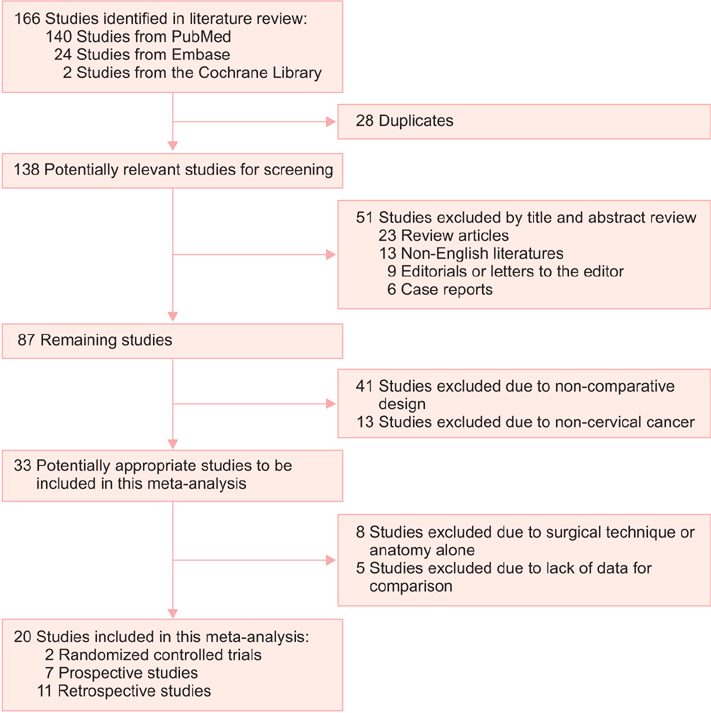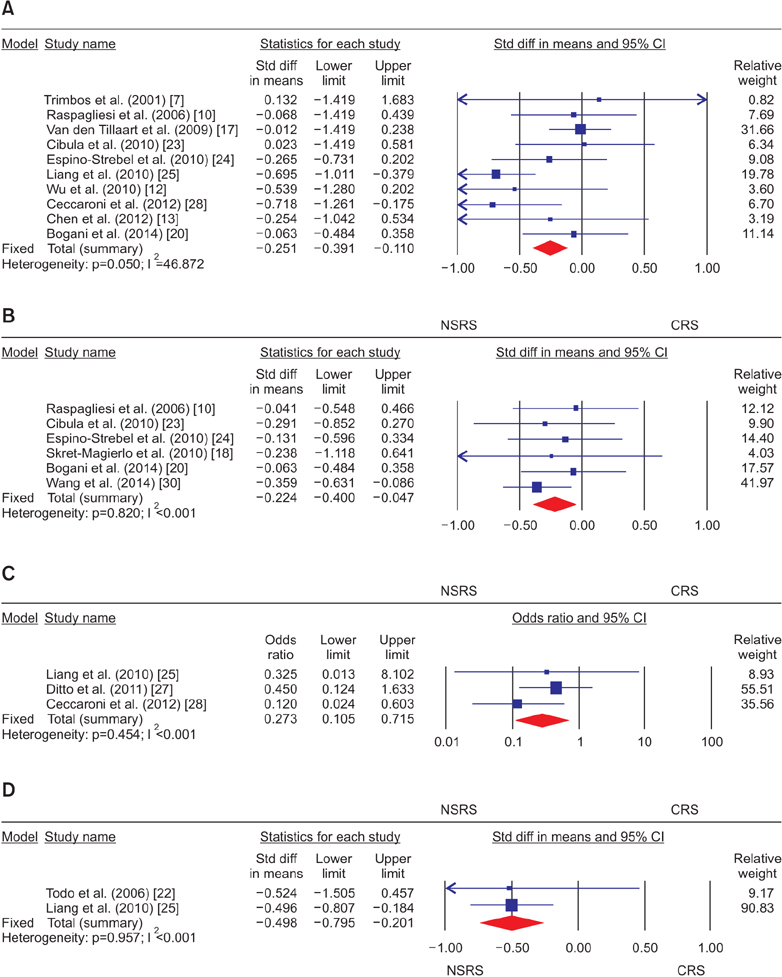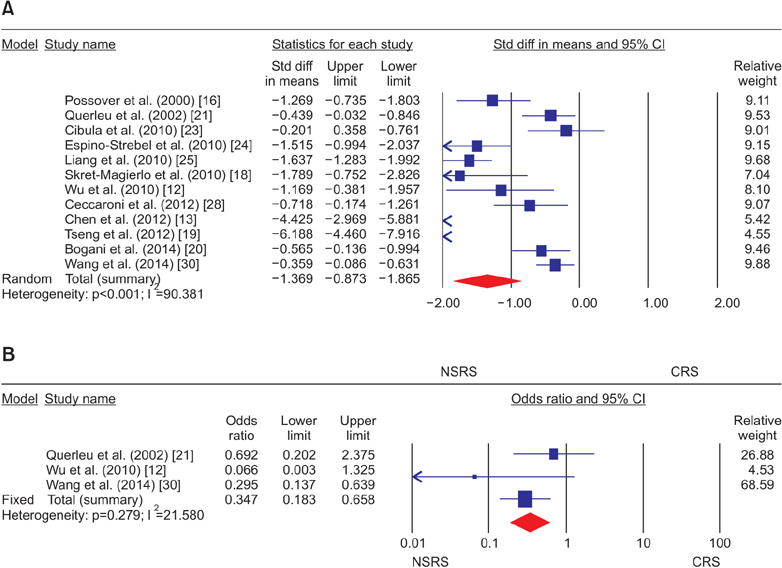J Gynecol Oncol.
2015 Apr;26(2):100-110. 10.3802/jgo.2015.26.2.100.
Conventional versus nerve-sparing radical surgery for cervical cancer: a meta-analysis
- Affiliations
-
- 1Cancer Research Institute, Seoul National University College of Medicine, Seoul, Korea. yssong@snu.ac.kr
- 2Department of Obstetrics and Gynecology, Seoul National University College of Medicine, Seoul, Korea.
- 3Department of Rehabilitation Medicine, Seoul National University College of Medicine, Seoul, Korea.
- 4Department of Surgery, Seoul National University College of Medicine, Seoul, Korea.
- 5Department of Anesthesiology and Pain Medicine, Seoul National University College of Medicine, Seoul, Korea.
- 6Department of Radiology, Seoul National University College of Medicine, Seoul, Korea.
- 7Department of Pathology, Seoul National University College of Medicine, Seoul, Korea.
- 8Department of Internal Medicine, Seoul National University College of Medicine, Seoul, Korea.
- 9Department of Urology, Seoul National University College of Medicine, Seoul, Korea.
- 10Major in Biomodulation, World Class University, Seoul National University, Seoul, Korea.
- KMID: 2160792
- DOI: http://doi.org/10.3802/jgo.2015.26.2.100
Abstract
OBJECTIVE
Although nerve-sparing radical surgery (NSRS) is an emerging technique for reducing surgery-related dysfunctions, its efficacy is controversial in patients with cervical cancer. Thus, we performed a meta-analysis to compare clinical outcomes, and urinary, anorectal, and sexual dysfunctions between conventional radical surgery (CRS) and NSRS.
METHODS
After searching PubMed, Embase, and the Cochrane Library, two randomized controlled trials, seven prospective and eleven retrospective cohort studies were included with 2,253 patients from January 2000 to February 2014. We performed crude analyses and then conducted subgroup analyses according to study design, quality of study, surgical approach, radicality, and adjustment for potential confounding factors.
RESULTS
Crude analyses showed decreases in blood loss, hospital stay, frequency of intraoperative complications, length of the resected vagina, duration of postoperative catheterization (DPC), urinary frequency, and abnormal sensation in NSRS, whereas there were no significant differences in other clinical parameters and dysfunctions between CRS and NSRS. In subgroup analyses, operative time was longer (standardized difference in means, 0.948; 95% confidence interval [CI], 0.642 to 1.253), while intraoperative complications were less common (odds ratio, 0.147; 95% CI, 0.035 to 0.621) in NSRS. Furthermore, subgroup analyses showed that DPC was shorter, urinary incontinence or frequency, and constipation were less frequent in NSRS without adverse effects on survival and sexual functions.
CONCLUSION
NSRS may not affect prognosis and sexual dysfunctions in patients with cervical cancer, whereas it may decrease intraoperative complications, and urinary and anorectal dysfunctions despite long operative time and short length of the resected vagina when compared with CRS.
Keyword
MeSH Terms
-
Constipation/epidemiology/etiology
Female
Humans
Hysterectomy/adverse effects/*methods
Intraoperative Complications/epidemiology
*Organ Sparing Treatments/adverse effects/methods
Pelvis/*innervation/surgery
Rectum/*innervation/surgery
Sexual Dysfunction, Physiological/epidemiology/etiology
Urinary Bladder/*innervation/surgery
Urinary Retention/epidemiology/etiology
Uterine Cervical Neoplasms/epidemiology/*surgery
Uterus/innervation/surgery
Vagina/innervation/surgery
Figure
Cited by 1 articles
-
Additional benefit of minimally invasive surgery to improve functional outcomes after radical hysterectomy
Jeong-Yeol Park
J Gynecol Oncol. 2019;30(2):. doi: 10.3802/jgo.2019.30.e64.
Reference
-
1. Ditto A, Martinelli F, Borreani C, Kusamura S, Hanozet F, Brunelli C, et al. Quality of life and sexual, bladder, and intestinal dysfunctions after class III nerve-sparing and class II radical hysterectomies: a questionnaire-based study. Int J Gynecol Cancer. 2009; 19:953–957.2. Kim HS, Choi CH, Lim MC, Chang SJ, Kim YB, Kim MA, et al. Safe criteria for less radical trachelectomy in patients with early-stage cervical cancer: a multicenter clinicopathologic study. Ann Surg Oncol. 2012; 19:1973–1979.3. Suh DH, Kim JW, Kang S, Kim HJ, Lee KH. Major clinical research advances in gynecologic cancer in 2013. J Gynecol Oncol. 2014; 25:236–248.4. Choi SY, Lee KH, Suk HJ, Chae HD, Kang BM, Kim CH. Successful pregnancy by direct intraperitoneal insemination in an infertile patient with failure of recanalization of isthmic stenosis after laparoscopic radical trachelectomy. Obstet Gynecol Sci. 2014; 57:82–85.5. Zullo MA, Manci N, Angioli R, Muzii L, Panici PB. Vesical dysfunctions after radical hysterectomy for cervical cancer: a critical review. Crit Rev Oncol Hematol. 2003; 48:287–293.6. Barnes W, Waggoner S, Delgado G, Maher K, Potkul R, Barter J, et al. Manometric characterization of rectal dysfunction following radical hysterectomy. Gynecol Oncol. 1991; 42:116–119.7. Trimbos JB, Maas CP, Deruiter MC, Peters AA, Kenter GG. A nervesparing radical hysterectomy: guidelines and feasibility in Western patients. Int J Gynecol Cancer. 2001; 11:180–186.8. Bergmark K, Avall-Lundqvist E, Dickman PW, Henningsohn L, Steineck G. Vaginal changes and sexuality in women with a history of cervical cancer. N Engl J Med. 1999; 340:1383–1389.9. Pieterse QD, Ter Kuile MM, Deruiter MC, Trimbos JB, Kenter GG, Maas CP. Vaginal blood flow after radical hysterectomy with and without nerve sparing. A preliminary report. Int J Gynecol Cancer. 2008; 18:576–583.10. Raspagliesi F, Ditto A, Fontanelli R, Zanaboni F, Solima E, Spatti G, et al. Type II versus type III nerve-sparing radical hysterectomy: comparison of lower urinary tract dysfunctions. Gynecol Oncol. 2006; 102:256–262.11. Li B, Zhang R, Wu LY, Zhang GY, Li X, Yu GZ. A prospective study on nerve-sparing radical hysterectomy in patients with cervical cancer. Zhonghua Fu Chan Ke Za Zhi. 2008; 43:606–610.12. Wu J, Liu X, Hua K, Hu C, Chen X, Lu X. Effect of nerve-sparing radical hysterectomy on bladder function recovery and quality of life in patients with cervical carcinoma. Int J Gynecol Cancer. 2010; 20:905–909.13. Chen C, Li W, Li F, Liu P, Zhou J, Lu L, et al. Classical and nerve-sparing radical hysterectomy: an evaluation of the nerve trauma in cardinal ligament. Gynecol Oncol. 2012; 125:245–251.14. Long Y, Yao DS, Pan XW, Ou TY. Clinical efficacy and safety of nerve-sparing radical hysterectomy for cervical cancer: a systematic review and meta-analysis. PLoS One. 2014; 9:e94116.15. Liberati A, Altman DG, Tetzlaff J, Mulrow C, Gotzsche PC, Ioannidis JP, et al. The PRISMA statement for reporting systematic reviews and meta-analyses of studies that evaluate health care interventions: explanation and elaboration. J Clin Epidemiol. 2009; 62:e1–e34.16. Possover M, Stober S, Plaul K, Schneider A. Identification and preservation of the motoric innervation of the bladder in radical hysterectomy type III. Gynecol Oncol. 2000; 79:154–157.17. van den Tillaart SA, Kenter GG, Peters AA, Dekker FW, Gaarenstroom KN, Fleuren GJ, et al. Nerve-sparing radical hysterectomy: local recurrence rate, feasibility, and safety in cervical cancer patients stage IA to IIA. Int J Gynecol Cancer. 2009; 19:39–45.18. Skret-Magierlo J, Narog M, Kruczek A, Kluza R, Kluz T, Magon T, et al. Radical hysterectomy during the transition period from traditional to nerve-sparing technique. Gynecol Oncol. 2010; 116:502–505.19. Tseng CJ, Shen HP, Lin YH, Lee CY, Wei-Cheng Chiu W. A prospective study of nerve-sparing radical hysterectomy for uterine cervical carcinoma in Taiwan. Taiwan J Obstet Gynecol. 2012; 51:55–59.20. Bogani G, Cromi A, Uccella S, Serati M, Casarin J, Pinelli C, et al. Nervesparing versus conventional laparoscopic radical hysterectomy: a minimum 12 months\' follow-up study. Int J Gynecol Cancer. 2014; 24:787–793.21. Querleu D, Narducci F, Poulard V, Lacaze S, Occelli B, Leblanc E, et al. Modified radical vaginal hysterectomy with or without laparoscopic nerve-sparing dissection: a comparative study. Gynecol Oncol. 2002; 85:154–158.22. Todo Y, Kuwabara M, Watari H, Ebina Y, Takeda M, Kudo M, et al. Urodynamic study on postsurgical bladder function in cervical cancer treated with systematic nerve-sparing radical hysterectomy. Int J Gynecol Cancer. 2006; 16:369–375.23. Cibula D, Slama J, Velechovska P, Fischerova D, Zikan M, Pinkavova I, et al. Factors affecting spontaneous voiding recovery after radical hysterectomy. Int J Gynecol Cancer. 2010; 20:685–690.24. Espino-Strebel EE, Luna JT, Domingo EJ. A comparison of the feasibility and safety of nerve-sparing radical hysterectomy with the conventional radical hysterectomy. Int J Gynecol Cancer. 2010; 20:1274–1283.25. Liang Z, Chen Y, Xu H, Li Y, Wang D. Laparoscopic nerve-sparing radical hysterectomy with fascia space dissection technique for cervical cancer: description of technique and outcomes. Gynecol Oncol. 2010; 119:202–207.26. Cibula D, Pinkavova I, Dusek L, Slama J, Zikan M, Fischerova D, et al. Local control after tailored surgical treatment of early cervical cancer. Int J Gynecol Cancer. 2011; 21:690–698.27. Ditto A, Martinelli F, Mattana F, Reato C, Solima E, Carcangiu M, et al. Class III nerve-sparing radical hysterectomy versus standard class III radical hysterectomy: an observational study. Ann Surg Oncol. 2011; 18:3469–3478.28. Ceccaroni M, Roviglione G, Spagnolo E, Casadio P, Clarizia R, Peiretti M, et al. Pelvic dysfunctions and quality of life after nerve-sparing radical hysterectomy: a multicenter comparative study. Anticancer Res. 2012; 32:581–588.29. Pieterse QD, Kenter GG, Maas CP, de Kroon CD, Creutzberg CL, Trimbos JB, et al. Self-reported sexual, bowel and bladder function in cervical cancer patients following different treatment modalities: longitudinal prospective cohort study. Int J Gynecol Cancer. 2013; 23:1717–1725.30. Wang W, Li B, Zuo J, Zhang G, Yang Y, Zeng H, et al. Evaluation of pelvic visceral functions after modified nerve-sparing radical hysterectomy. Chin Med J (Engl). 2014; 127:696–701.31. Piver MS, Rutledge F, Smith JP. Five classes of extended hysterectomy for women with cervical cancer. Obstet Gynecol. 1974; 44:265–272.32. Querleu D, Morrow CP. Classification of radical hysterectomy. Lancet Oncol. 2008; 9:297–303.33. Wells GA, Shea B, Oconnell D, Peterson J, Welch V, Losos M, et al. The Newcastle-Ottawa Scale (NOS) for assessing the quality of nonrandomised studies in meta-analyses [Internet]. Ottawa: Ottawa Hospital Research Institute;c2014. cited 2015 Mar 17. Available from: http://www.ohri.ca/programs/clinical_epidemiology/oxford.asp.34. Tierney JF, Stewart LA, Ghersi D, Burdett S, Sydes MR. Practical methods for incorporating summary time-to-event data into metaanalysis. Trials. 2007; 8:16.35. Higgins JP, Thompson SG, Deeks JJ, Altman DG. Measuring inconsistency in meta-analyses. BMJ. 2003; 327:557–560.36. Sun L, Wu LY, Zhang WH, Li XG, Song Y, Zhang X. Preliminary study of nerve sparing radical hysterectomy in patients with cervical cancer. Zhonghua Zhong Liu Za Zhi. 2009; 31:607–611.37. Long Y, Yao DS, Gao K, Xie XL. Preliminary study on clinical effect of nerve sparing radical hysterectomy for cervical cancer. Chin Clin Oncol. 2010; 15:1083–1090.38. Zhu T, Yu AJ, Shou HF, Chen X, Zhu JQ, Yang ZY, et al. Feasibility of unilateral or bilateral nerve-sparing radical hysterectomy in patients with cervical cancer and evaluation of the post-surgery recovery of the bladder and rectal function. Zhonghua Zhong Liu Za Zhi. 2011; 33:53–57.39. Chen Y, Li Y, Xu HC, Li JN, Li YY, Liang ZQ. Laparoscopic anatomical nerve sparing radical hysterectomy for cervical cancer: a clinical analysis of 37 cases. Zhonghua Fu Chan Ke Za Zhi. 2009; 44:359–363.40. Zhang Y, Wang D, Ma Y, Pan CQ. A clinical study of surgical treatment of the cervical cancer with laparoscopic nerve sparing radical hysterectomy. Prog Obstet Gynecol. 2010; 19:31–32.41. Lu Y, Yao DS, Mo LZ, Li F, Pan ZM. Preliminary clinical study of laparoscopic pelvic autonomic nerve-plane sparing radical hystrectomy. Chin Clin Oncol. 2012; 17:347–350.42. Liang JT, Chien CT, Chang KJ, Hsu HC, Chu SH, Lai MK, et al. Neurophysiological basis of sympathetic nerve-preserving surgery for lower rectal cancer: a canine model. Hepatogastroenterology. 1998; 45:2206–2214.43. Raspagliesi F, Ditto A, Fontanelli R, Solima E, Hanozet F, Zanaboni F, et al. Nerve-sparing radical hysterectomy: a surgical technique for preserving the autonomic hypogastric nerve. Gynecol Oncol. 2004; 93:307–314.44. Hockel M. Do we need a new classification for radical hysterectomy? Insights in surgical anatomy and local tumor spread from human embryology. Gynecol Oncol. 2007; 107:1 Suppl 1. S106–S112.45. Dursun P, LeBlanc E, Nogueira MC. Radical vaginal trachelectomy (Dargent\'s operation): a critical review of the literature. Eur J Surg Oncol. 2007; 33:933–941.46. Rob L, Halaska M, Robova H. Nerve-sparing and individually tailored surgery for cervical cancer. Lancet Oncol. 2010; 11:292–301.47. Brown JS, Sawaya G, Thom DH, Grady D. Hysterectomy and urinary incontinence: a systematic review. Lancet. 2000; 356:535–539.48. Raspagliesi F, Ditto A, Hanozet F, Martinelli F, Solima E, Zanaboni F, et al. Nerve-sparing radical hysterectomy in cervical cancer: evolution of concepts. Gynecol Oncol. 2007; 107:1 Suppl 1. S119–S121.49. Papka RE, Mowa CN. Estrogen receptors in the spinal cord, sensory ganglia, and pelvic autonomic ganglia. Int Rev Cytol. 2003; 231:91–127.50. Maas CP, ter Kuile MM, Laan E, Tuijnman CC, Weijenborg PT, Trimbos JB, et al. Objective assessment of sexual arousal in women with a history of hysterectomy. BJOG. 2004; 111:456–462.51. Ercoli A, Delmas V, Gadonneix P, Fanfani F, Villet R, Paparella P, et al. Classical and nerve-sparing radical hysterectomy: an evaluation of the risk of injury to the autonomous pelvic nerves. Surg Radiol Anat. 2003; 25:200–206.
- Full Text Links
- Actions
-
Cited
- CITED
-
- Close
- Share
- Similar articles
-
- Nerve-sparing radical hysterectomy: time for a new standard of care for cervical cancer?
- Minimally invasive surgery improves short-term outcomes of nerve-sparing radical hysterectomy in patients with cervical cancer: a propensity-matched analysis with open abdominal surgery
- Nerve-sparing radical hysterectomy in the precision surgery for cervical cancer
- Improved bladder function in radical hysterectomy without worsening oncologic outcome: resection of the posterior layer of the vesicouterine ligament with the procedure limited to the vesical veins
- Oncologic effectiveness of nerve-sparing radical hysterectomy in cervical cancer




